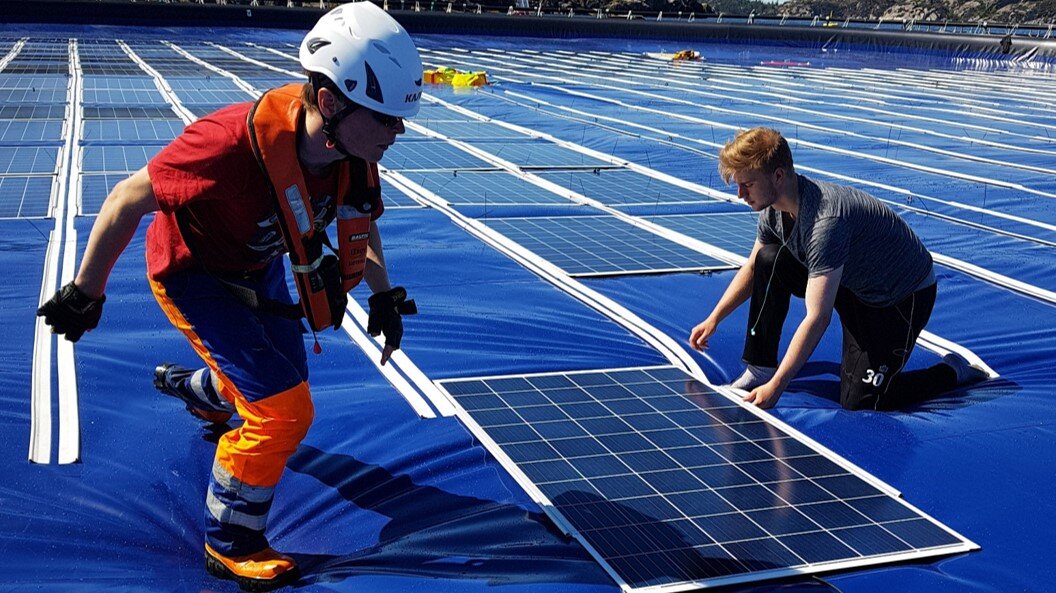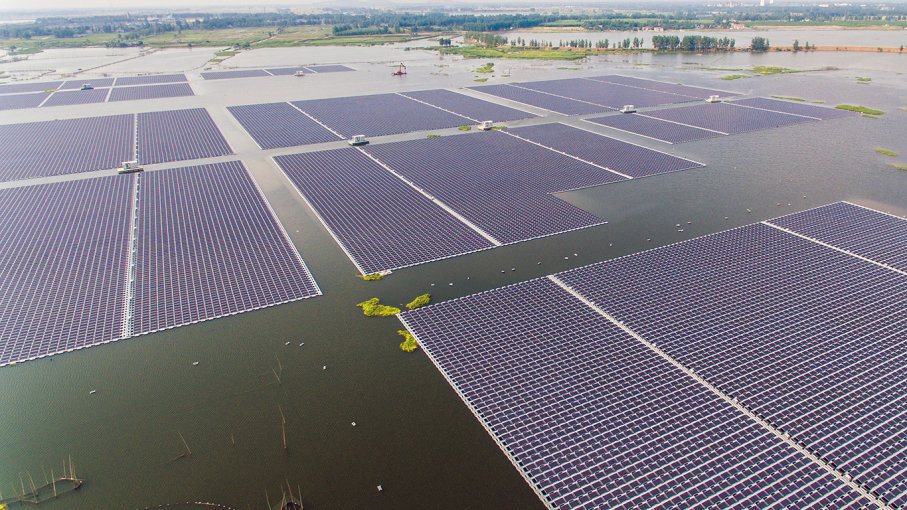The Case for Floating Solar
Summary - We should build gigantic, ridiculously large floating solar fields in key areas around the world close to existing shipping hubs and ports. These islands will provide independent energy for seasonal storage and can provide synthetic, circular fuel to existing infrastructure.
People think we need energy. Truth is, we do not.
We need heating, lighting and transportation. At the right place, on the right time. Generating energy is not the issue: one hour of sunlight provides enough energy to power the world for a year. The trick is how to transform this into useful energy and store it.
So how can we combine the cheapest form of energy generation with energy storage? What is the best place to generate gigantic, ridiculous amounts of energy? As in gigawatts of energy, the size of small countries? In the desert with solar energy? Think again.
I believe that offshore floating solar farms will provide the best and most economic option for storing huge amounts of energy in the future. In this article I will make the case for creating huge floating solar farms offshore in order to fuel the future.
Giant Floating Solar
Combining the power of the Sun and the potential of the Sea to become energy independent on 100% green energy. What’s not to like?
Humanity has 99 problems but energy generation ain’t one
That’s right. There is no silver-bullet invention required to generate cheap renewable energy. We already have that. It is called Solar PV. Solar energy has become so cheap and abundant, we have yet to come to grips with it. With prices between 1-2 cents per kWh, it is becoming a near free commodity. It is so cheap even, it might be detrimental for making a proper business case if you sell it per kWh. The issue of the energy transition is therefore not to generate energy, but how to store it. And I am not talking about short-term energy storage. Graphene batteries will solve that (and at the same time make all land-based transportation electrical). I am talking long-range marine transport and long-term energy storage.
A second problem humanity needs to face, is marine pollution. There is much controversy surrounding the exact amount of pollution. Naturally it is a very heated debate as there are many stakeholders with big wallets involved. What I can attest to however, breathing and living in the offshore industry for almost 8 years now, is that the marine industry is, in fact, very dirty. It can be stated that ships are responsible for more than 18 percent of some air pollutants. This is due to the fact that most large vessels burn HFO, which is pretty much the most polluting fuel in the world. It is like heating the tarmac from your street and putting it in your engine. It is nasty stuff. Why then are we willing to poison ourselves and the environment by burning HFO? Mainly because of the fact that it is burned far away at sea where nobody sees it, in combination with our third problem: HFO is very cheap.
Like most other marine fuels, HFO is created from crude oil. This is essentially dinosaur juice, pumped up from reservoirs kilometers deep where it is polluted with extreme toxins like sulfur or radioactive materials. Crude oil is then shipped and stuffed into a refinery, where the different components are separated. Some of these components have always been very useful to men, such as lamp oil for lighting. The more “heavier” components of the crude oil however, what is left at the “bottom of the barrel”, has always been a nasty waste material for the refineries. At first, nobody would want it and it was very costly to do something with it, so most of the time it was simply burned. Then someone had the brilliant idea to sell it as fuel. This means that nowadays, refineries receive income from selling HFO instead of needing to pay for it as waste. Consequently, there is a big financial incentive for refineries to sell the HFO. It needs “to go somewhere”. To put a long story short: the refineries are geared towards producing and selling HFO and cannot simply stop without losing a lot of money.
Let’s summarize our problems. We use an extremely polluting fuel to power our global economy, which is made by refineries who cannot do anything else with it and are therefore forced to sell it. On top of this, we do not have a viable solution to large scale energy storage. How can we change this? Gigantic floating solar farms.
Connecting offshore deserts to marine traffic: floating solar
What I propose is to create giant offshore solar farms at key locations in the world that provide circular fuel for marine transportation and circular feedstock for the chemical industry. Electrical energy is provided by solar PV in the form of floating solar farms that are kilometers large. Enough to power a large chemical plant, i.e. at least several hundreds of MW. The energy is used for the production of hydrogen gas by means of electrolysis. Because the farms are offshore, water is freely available (as opposed to solar energy in the desert).
The hydrogen is then compressed, to be freely and “easily” transported across the globe as fuel or as feedstock for the chemical industry. Excess produce can be shipped to any regional market to ensure supply equals demand. The farms are placed on key locations around the world called “hubs”, much like modern day refineries are placed in strategically chosen hubs with good connections to shipping routes and access to important markets. Transportation of hydrogen between the different intercontinental hubs could potentially even be done autonomously, using the circular hydrogen generated by the solar farms itself.
Hydrogen can potentially be converted to several forms of hydrocarbons, such as diesel or LNG. This can be done by means of the Fischer-Tropsch process, where a mixture of carbon and hydrogen are transformed into liquid hydrocarbons. One can “easily” take the CO2 from the seawater or even the air. Shell is actually using the Fischer-Tropsch process in their Pearl installation in Qatar, but they use natural gas as a feedstock. The same chemical processes can be used to create a fully circular fuel using renewable energy.
Placing large floating solar farms offshore actually makes sense if you combine the major shipping lines in the world with the solar irradiance graphs. You can immediately see that the major shipping hubs in the world are close to the best spots in the world to collect solar energy from. This is shown below. Most of the shipping in our world is somehow miraculously close to gigantic amounts of solar energy. We do not need deserts for solar energy. We need the oceans right next to them.
Wait, but why?
The major benefit of creating circular fuel for marine transport is that existing equipment can make use of it without any conversions. You can create a so called “drop-in” fuel without the need to invest in your vessels. Especially large vessels and marine equipment are at an benefit. Why? We tend to forget that vessels being built now (2020) will sail the world for the coming 20 to 30 years at least (=2050). By this time the world needs to be carbon neutral! In other words, we should either make carbon neutral vessels now, or we start using circular fuels in due time. The alternative is to spend a lot of money to convert your vessel and make it fit for the future. This is very costly, which means there will most likely be a lot of shipowners that will not be able to convert. A circular fuel would be a perfect economical solution for this.
The same concept of “drop-in” fuel can be applied to the chemical industry. Hundreds of billions of dollars are invested around to world into fossil fuel refineries. We cannot simply abandon these investments, as we would probably hurl ourselves into an economic crisis of epic proportions (though that might happen either way, check out this article about the looming carbon bubble). A circular feedstock for refineries that makes use of the existing infrastructure therefore will ensure our investments are safe.
Another benefit is the fact that energy supply from these solar farms is less dependent from politically unstable countries or trade “wars”. This is because the offshore structure can be constructed in areas with politically more stable regimes, potentially even in international waters. For example, suppose there is a drone strike on an important refinery somewhere in the Middle East (purely hypothetical example of course). What happens to the oil price? It rises significantly because everyone gets jumpy. Only some traders are happy with this. Giant solar arrays that provide energy on key locations across the world in stable regions will provide stability to energy markets.
Finally, floating solar farms are based on existing, matured technologies. The offshore, solar and chemical industries all have key components of the puzzle. They simply need to be combined. China already created the largest floating solar power plant back in 2017 on lakes in central Anhui province based on rigid panels. I bet there are even bigger ones by now. Meanwhile, a lot of energy is being put into floating solar research and newer more sturdy designs are being made. One of these is the floating solar trampoline by Ocean Sun. Their modular design can be readily copied for use around the world.
If it is so great, why are we not doing this?
Mostly money. However, before I go into that question, I need to get something of my chest first. The idea of floating solar itself is not mine. I simply became an ambassador of it.
I was part of a consortium of industry and knowledge partners called BlueS, which stands for Blue Solar. The goal of this project was to set up a large scale research program to make large offshore solar farms a reality (see below). Blues was one of the finalists in Our Oceans Challenge, a platform for sustainable ideas in the offshore industry. Unfortunately, whilst the interest of several oil and gas majors was raised who pledged quite a lot of funds, the project did not manage to accumulate enough to get started.
So why are we not doing this? Most likely because of the upfront investments required, which is in the order of billions. The fact that it has never been done before is associated with a lot of risk for investors. Additionally it takes a lot of effort to build such an industry from the ground up. We know that Rome was not built in a day. The same applies to a giant interconnected network of solar farms producing circular fuel and chemical feedstock around the world.
Nonetheless, I honestly believe it is only a matter of time before someone connects the dots and uses ridiculously cheap solar energy to create circular fuel. It is the fuel humanity deserves, but not the one it needs right now. Someday however, I hope to be connecting those dots.
Ownership of the BlueS project lies with TU Delft, contact Sebastian Schreier for more information. Special thanks goes out to Mirek Kaminski.





